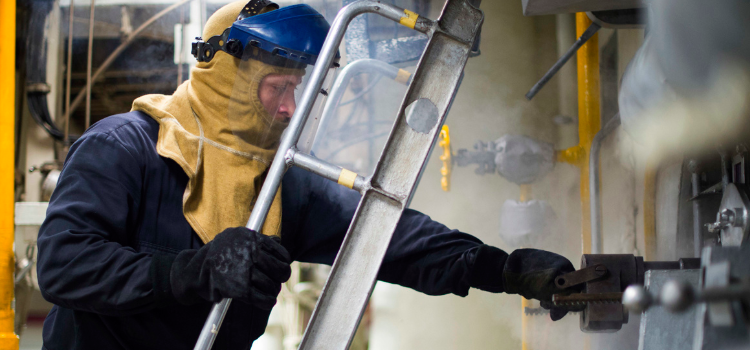American warships are capable, lethal, and imposing, so much so that it can be easy to forget that they are still just lumps of metal floating through highly damaging saltwater while running at high power as hundreds or thousands of sailors prowl their decks.
Here’s how sailors make sure that all the sailing, work, and seawater doesn’t doom the ship before it can shoot its way through enemy fleets:

Hull Maintenance Technician 2nd Class Ryann Galbraith brazes piping aboard the aircraft carrier USS Theodore Roosevelt.
(U.S. Navy Mass Communication Specialist Seaman Michael Hogan)
One of the most important parts, besides avoiding enemy missiles and shells, obviously, is making sure that the saltwater stays in the ocean and doesn’t get inside the ship. That’s why the Navy has hull maintenance technicians like Ryann Galbraith, above. They work on all the plumbing, decks, structures, and hulls, patching, welding, riveting, etc. to keep fluids and steam in dedicated pipes.

U.S. Navy divers, assigned to Southwest Regional Maintenance Center, drop a cofferdam into the water prior to performing underwater hull maintenance on the amphibious assault ship USS Boxer.
(U.S. Navy Mass Communication Specialist 2nd Class Trevor Welsh)
Of course, the hull itself can be vulnerable, accumulating barnacles and other sea life and rusting from the exposure to water and salt. To deal with this, the Navy sends sailors around the ship, often in small boats, to touch up paint or clean off risky accumulations. Also, they send divers under the water to clean the hull and perform more maintenance.

Chief Fire Controlman Ryan Pavelich and Fire Controlman 2nd Class Robin Norris inspect the closed-in weapons system on the USS Wayne E. Meyer.
(U.S. Navy Mass Communication Specialist 3rd Class Kelsey L. Adams)
But the ship also needs to be able to hit back if it comes under attack, and weapons like the Phalanx close-in weapons system allow it to knock the enemy’s missiles and other airborne threats out of the sky. But, you guessed it, all those moving parts and sensitive electronics need a lot of maintenance as well.
Wires fray, parts wear out, electronics degrade. Fire control sailors make sure their weapons will protect the ship when called upon.

Chief Machinist Mate Benjamin Carnes and Gas Turbine Systems Technician 1st Class Johnathan Hovinga make final inspections in preparation to start the main engines on the littoral combat ship USS Fort Worth.
(U.S. Navy Mass Communication Specialist 2nd Class Antonio P. Turretto Ramos)
The maintenance can get a lot more complicated when you go inside the ship. The engines on Navy ships, whether fueled by diesel, gasoline, or nuclear, are pretty complicated. They need to be regularly inspected, pumps and belts have to get replaced, oil and other fluids need to be changed.
And that’s all if everything goes according to plan. When engines experience a real breakdown, it can necessitate people crawling through the engine or the ship getting towed into port for drydock maintenance. So, doing the maintenance is worth the effort.

Gas Turbine System Technician Fireman Steven Garris, from Youngsville, Pennsylvania, changes a burner barrel to prevent soot build up in a boiler aboard amphibious assault ship USS Bonhomme Richard.
(U.S. Navy Mass Communication Specialist 2nd Class Diana Quinlan)
But Navy engines actually have a lot of maintenance needs with few civilian equivalents. The sailor above is changing out the burner barrel on an amphibious assault ship. Do any of your vehicles have burner barrels? Mine don’t. And few people need specially trained staff to keep their nuclear reactors from poisoning the passengers.

Onboard USS Wasp, Petty Officer 2nd Class Jarrod Prouse conducts repairs on the handle of a Collective Protective System hatch.
(U.S. Navy Petty Officer 1st Class Rebekah Adler)
Other routine maintenance on ships is much more sensitive and demanding as well. Navy ships have doors that need to be welded properly, or else lethal substances could leak through when the ship is in a chemical, biological, radiological, or nuclear environment.

Hull Maintenance Technician 2nd Class Alexander Fleischer, from Crystal Lake, Ill., assigned to the submarine tender USS Frank Cable, welds a gusset while performing repairs to the cradle of a crane aboard the ship.
(U.S. Navy Mass Communication Specialist 3rd Class Heather C. Wamsley)
By the way, there are so, so many pictures online of sailors welding. That’s not surprising since ships are made of metal and that metal needs to be repaired. But still, so many pictures. This particular one shows a hull maintenance technician repairing a crane cradle on a submarine tender.

Aviation Boatswain’s Mate 1st Class Scott Skeate, Aviation Boatswain’s Mate 1st Class Darryl Johnson, Aviation Boatswain’s Mate 2nd Class Luke Hart, and Airman Apprentice Mccord Brickle perform maintenance on a waist catapult shuttle on the flight deck of the aircraft carrier USS Nimitz.
(U.S. Navy Mass Communication Specialist 3rd Class Jacob Milner)
Most Navy ships have specialty systems not seen on civilian vessels or even on most other vessels of the fleet. For instance, carriers have catapults that, except for the USS Gerald R. Ford, are powered by steam. The catapults have to be repaired as parts wear out, and they have to be carefully calibrated even when everything is working properly.
This article originally appeared on We Are The Mighty
More From We Are The Mighty
Navy Vying to Be the Most Inked Service with New Tattoo Policy
7 Things to Do Before You Get that New Tattoo
The Irish-American Who Invented the Modern Tattoo Machine
Follow We Are The Mighty on Twitter
READ NEXT: WHY TATTOOS ARE ONE OF THE MOST TIME-HONORED TRADITIONS
READ NEXT: THE MEANING BEHIND 19 CLASSIC NAVY TATTOOS
READ NEXT: HOW DOUGHNUTS HAVE A STORIED HISTORY IN THE TRENCHES









